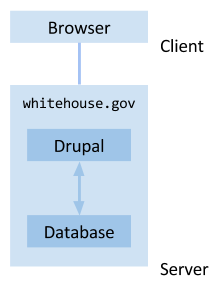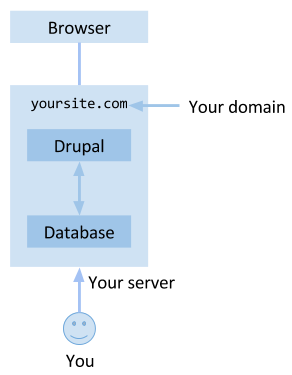Drupal is a content management system (CMS). CMS help you build Web sites. Good CMS do more. They help you build complete applications. Drupal is a good CMS.
Browsers and servers
You access Drupal sites with a Web browser, like Firefox or Chrome. Whether you’re using a laptop, tablet, or phone, you always use a Web browser on that device.
whitehouse.gov is a Drupal site. Thousands of people look at the site every day. They all see the same homepage. How can that be, when everyone is running browsers on their own devices?
Because the data for whitehouse.gov is on a server. A server is a computer that other computers talk to. When you tell Firefox on your phone to show whitehouse.gov, you’re really telling it to connect to the server at whitehouse.gov, download content, and show it to you.
The whitehouse.gov server has the Drupal software installed on it. Drupal sits around, twiddling its digital thumbs, until your browser asks it for a page. The content is kept in a database; you don’t need to know what it is, just that Drupal stores content in a database. Drupal grabs the content you ask for from the database, gives it fonts, colors, headers, and things, and sends it to your browser.

Breaking work into chunks, and putting them on different computers, is one of the Big Ideas of IS.
Your Drupal site
You need the same thing to make Drupal sites:

You need your own domain, like lucy-smithers.com, or dynamonkey.net. It will cost you about $10 per year. That just gives you rights to use the name.
Pick a domain you can put on a resume. Like:
- lucy-smithers.com
- lucysmithers.net
- lucy-smithers.me
- smithereens-lucy.info
- lucysmithe.rs
You can use words that make sense professionally, like:
- smithersthegeek.com
- accounting-with-lucy.net
- lucy-the-hr-diva.com
(Maybe dynamonkey.net isn’t so good after all.)
BTW, you can buy another domain, if you find one you like better. They’re cheap. You can point more than one domain at the same Web site.
You also need a server to attach your domain to. You rent that from a Web hosting company. The cheapest type of hosting is shared hosting. That’s all you need for this course. Reclaim Hosting is a good choice. It was created for students. It has what you’ll need for this course.
Subdomains
You’ll be installing a different copy of Drupal for each of your projects. Each one is called a Drupal instance. Each one will have its own set of Drupal files, and its own database.
You’ll run them on the same domain, like calmcamel.net. You don’t want the Drupal instances to interfere with each other. How to do that?
That’s where subdomains come in. A subdomain is a slice of a domain, with an extra name in front. For example:
- strange.calmcamel.net
- project1.calmcamel.net
- soft-kitty-warm-kitty.calmcamel.net
Each one can have a different Drupal Web site on it.
Open source
Drupal is open source. That means anyone can download and use it for free.
It also means that anyone can contribute to the project. Writing code, testing, documentation, other things. Drupal 8, the latest version, had over 2,000 contributors when it was released. Thousands more write Drupal extensions, like modules and themes. You’ll learn about them later.
The Drupal community is large, active, and helpful. It’s hard to say how many people use Drupal. Over one million accounts have been created on Drupal.Org, Drupal’s main site. Not all are active. Still, we can say that there are a lot of Drupalistas out there.
There’s also a Drupal support industry. These companies help with training, operations, custom development, scaling, you name it.
If you’re a student, consider contributing to Drupal. Add your work to your portfolio. You don’t have to be a programmer. For example, English majors could help with documentation.
Summary
You access a Drupal site with a Web browser. The site’s data is on a server. A server is a computer that other computers talk to.
You need your own domain. Pick one you can put on a resume.
You also need a server to attach your domain to. That’s what a Web hosting account gives you.
A subdomain is a slice of a domain, with an extra name in front. Each one can have a different Drupal Web site on it.
Drupal is open source.
